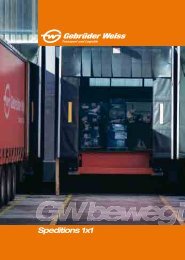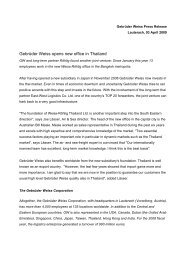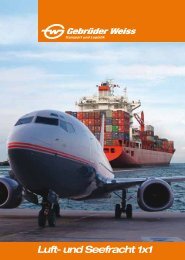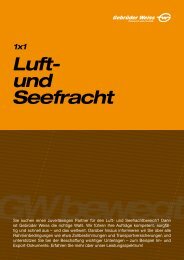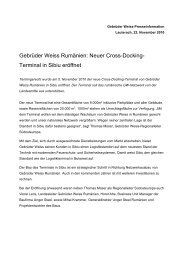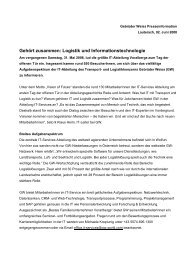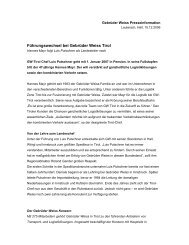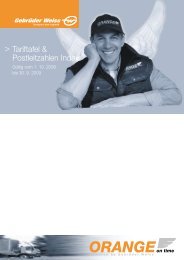The Air & Sea Magazine from Gebrüder Weiss 01/2011
The Air & Sea Magazine from Gebrüder Weiss 01/2011
The Air & Sea Magazine from Gebrüder Weiss 01/2011
Create successful ePaper yourself
Turn your PDF publications into a flip-book with our unique Google optimized e-Paper software.
<strong>01</strong>/2<strong>01</strong>1<br />
Incoterms 2<strong>01</strong>0:<br />
What‘s new?<br />
orange globe looks at what has changed in<br />
the new version of the commercial terms.<br />
More <strong>from</strong> page 2<br />
Central & Eastern<br />
Europe in focus<br />
<strong>Gebrüder</strong> <strong>Weiss</strong> <strong>Air</strong> & <strong>Sea</strong> is also well<br />
positioned in CEE as the local experts in<br />
air and sea freight in eleven countries.<br />
Pages 6/7<br />
<strong>The</strong> <strong>Air</strong> & <strong>Sea</strong> <strong>Magazine</strong> <strong>from</strong> <strong>Gebrüder</strong> <strong>Weiss</strong><br />
Between yesterday<br />
and tomorrow<br />
A historical ramble through 500 years<br />
of GW - <strong>from</strong> its roots as a messenger<br />
service to a global logistics group.<br />
Page 8
orange globe – editorial<br />
<strong>The</strong> Eastern European Dream<br />
During the 1980s <strong>Gebrüder</strong> <strong>Weiss</strong> reached<br />
out almost simultaneously to the Asian and<br />
Eastern European markets. Here and there<br />
they laid the foundations for a powerful<br />
logistics organisation.<br />
Although people could tell a change was<br />
about to come, it was rather a surprise how<br />
quickly the Iron Curtain fell in 1989. When the borders<br />
were opened, GW realised its opportunities. <strong>The</strong>refore,<br />
GW did not hesitate to establish representative offices in<br />
Hungary, the former Czechoslovakia and Slovenia – later<br />
we also opened such offices in many more so-called<br />
south-east European countries. Over the years these<br />
have developed into fully-fledged logistics sites.<br />
We knew that these countries were in a position where<br />
they needed to catch up. <strong>The</strong> people there were interested,<br />
curious, but also very cautious. People living in “the<br />
West” on the other hand were rather reserved and felt like<br />
they knew everything better! This was the true challenge<br />
for us: finding the right balance between the different<br />
standards, systems, cultures and “the rules how to play”<br />
in those new countries within our group at very unequal<br />
development stages. Looking back we definitely made<br />
some mistakes, but we also did many things right:<br />
By now <strong>Gebrüder</strong> <strong>Weiss</strong> is present in 11 countries in<br />
Central and Eastern Europe. It is hard to tell whether<br />
we are market leader in the region. However, this is not<br />
the point! More important is that GW has got a relevant<br />
size there.<br />
In the beginning, the goods to and <strong>from</strong> Austria, Europe<br />
or even overseas had mainly been transferred via our<br />
Vienna branch. Step by step, the teams in the new countries<br />
became more independent, so that other transport<br />
routes were used. Eventually, apart <strong>from</strong> a solid surface<br />
and logistics organisation, independent <strong>Air</strong> & <strong>Sea</strong><br />
branches could be established at the most important<br />
locations. In our core market, the Alps-Danube region,<br />
we aim to be a logistics provider for all kinds of logistics<br />
needs. Locally situated but globally connected <strong>Air</strong> & <strong>Sea</strong><br />
teams form a part of that – even in smaller countries or<br />
regions.<br />
For sure, the crisis has hit the still quite weak economies<br />
of the CEE region especially hard. Many of these<br />
countries have suffered an enormous setback. However,<br />
I am convinced that the economic growth has not been<br />
stopped for long since there is still a lot of potential for<br />
growth and development.<br />
Heinz Senger-<strong>Weiss</strong>, Member of the Board<br />
GW <strong>Air</strong> & <strong>Sea</strong> Contact<br />
<strong>Gebrüder</strong> <strong>Weiss</strong> GmbH<br />
Bundesstraße 110, A-6923 Lauterach<br />
T +43.5574.696.2207<br />
F +43.5.9006.2609<br />
air-sea@gw-world.com<br />
www.gw-world.com<br />
orange globe<br />
forwarder‘s abc<br />
Summary reports<br />
Deadlines for air & sea freight<br />
Since the beginning of the year, mandatory import (ENS) and export (EXS) declarations must be submitted<br />
to the customs authorities for goods imported to or exported <strong>from</strong> the EU customs area. Statutory deadlines<br />
must be met to ensure that computer-aided risk analyses can be performed based on this information.<br />
Exceptions to the general rule include trading with Switzerland and Norway.<br />
<strong>Air</strong><br />
• For short haul flights (less than 4 hours duration),<br />
the ENS must be lodged no later than when the aircraft<br />
takes off.<br />
• For long haul flights (more than 4 hours duration),<br />
the ENS must be available at least four hours prior<br />
to arrival of the consignment at the first airport in<br />
the customs territory of entry in the EU.<br />
• For exports, <strong>Gebrüder</strong> <strong>Weiss</strong> submits the safety<br />
data at the time of the export declaration (if GW<br />
prepares the export clearance documentation).<br />
Viewed critically<br />
Incoterms 2<strong>01</strong>0<br />
Michael Büchele, Manager Marketing & Sales <strong>Air</strong> & <strong>Sea</strong> at <strong>Gebrüder</strong> <strong>Weiss</strong>, explains what<br />
has changed in the current version of the commercial terms and what is worthy of particular<br />
attention in practice.<br />
It is 75 years since the International<br />
Chamber of Commerce ICC<br />
first published a series of rules on<br />
the division of obligations, costs<br />
and risk in relation to the transport<br />
organisation, loading, unloading,<br />
insurance and customs clearance.<br />
Since then the Incoterms (International<br />
Commercial terms) have developed<br />
into an undisputed standard<br />
that is regularly revised and adapted to common practice.<br />
<strong>The</strong> Incoterms 2<strong>01</strong>0 have now come into force with effect<br />
<strong>from</strong> 1 January 2<strong>01</strong>1.<br />
New rules - new place of delivery<br />
for some terms<br />
In particular this new version, which supersedes the version<br />
dating <strong>from</strong> 2000, aims for better comprehensibility<br />
and simpler application of the delivery terms. So now there<br />
are only 11 terms instead of 13, which are divided into two<br />
categories: terms that apply generally to all forms of freight<br />
(EXW, FCA, CPT, CIP, DAT, DAP, DDP) and terms for sea<br />
freight and transport on inland waterways (FAS, FOB, CFR,<br />
CIF). In addition, the new Incoterms DAT (“Delivered at Terminal”)<br />
and DAP (“Delivered at Place”) replace the previous<br />
terms DEQ, DAF, DES and DDU.<br />
<strong>Sea</strong><br />
• For container freight, the ENS must be lodged at<br />
least 24 hours before commencement of loading in<br />
the port of departure.<br />
• For break bulk, the ENS must also be lodged at<br />
least 24 hours before commencement of loading in<br />
the port of departure.<br />
• For exports, the safety data is automatically lodged<br />
as part of the electronic export declaration by GW.<br />
Last but not least, the place of delivery has been re-defined<br />
for the existing terms FOB, CFR and CIF: pursuant to<br />
Incoterms 2<strong>01</strong>0, goods are only regarded as having been<br />
delivered once they are on board the ship, and not as previously,<br />
at the reeling of the ship. Here too it is essential to<br />
define the precise location, i.e. the port and possibly the<br />
area of the port, to which the goods should be delivered. If<br />
FOB is agreed but no port is defined, it is up to the seller to<br />
determine the location.<br />
Important version check<br />
Pursuant to the ICC, Incoterms may be used for both domestic<br />
and to international purchase contracts. Contracts<br />
based on older versions such as Incoterms 2000 will remain<br />
unaffected by the latest changes. Pursuant to the ICC, the<br />
latest valid version of the Incoterms will always apply unless<br />
otherwise agreed. <strong>The</strong>oretically, however, it is still possible<br />
to conclude purchase contracts based on earlier versions.<br />
<strong>The</strong> seller and buyer should therefore clearly define in the<br />
contract which version of the Incoterms has been used as<br />
the basis, for example “FOB Hamburg, Incoterms 2<strong>01</strong>0”.<br />
Your local <strong>Gebrüder</strong> <strong>Weiss</strong> adviser can help if you have any<br />
questions about the new terms.
orange globe – topic<br />
No Incoterm without<br />
a place of supply<br />
A key component of an Incoterm is the precise designation of the place of delivery i.e.<br />
the place at which the risk passes <strong>from</strong> the seller to the buyer. With the exception of the<br />
C terms, this is also the place at which the costs pass to the buyer. orange globe looks at<br />
why it is so important to leave no room for interpretation in the definition of location and<br />
how misunderstandings can be avoided <strong>from</strong> the outset.<br />
In the Incoterms 2<strong>01</strong>0, four “Delivered” terms have<br />
been replaced by two new terms: DDU, DAF and<br />
DES have been replaced by DAP and DEQ by DAT;<br />
DDP has been retained in the Incoterms 2<strong>01</strong>0. DAP<br />
means that the seller bears the costs and risk until<br />
the goods are delivered to the named destination<br />
place ready for unloading. This may be the port<br />
or airport of arrival, for example, a haulage warehouse,<br />
border crossing or the buyer‘s warehouse.<br />
Precisely define the location<br />
According to Klemens Strohmer, Operations Manager<br />
<strong>Air</strong> & <strong>Sea</strong> CEEC at <strong>Gebrüder</strong> <strong>Weiss</strong>, however, “DAP<br />
Shanghai” can be interpreted differently: “namely that<br />
the goods are deemed to have been delivered when they<br />
are made available without unloading on the ship arriving<br />
in the port of Shanghai, on the HGV at a haulage terminal<br />
in Shanghai port or at the buyer‘s warehouse”. To avoid<br />
misunderstandings and conflicts, therefore, in addition to<br />
“DAP Shanghai”, a declaration should be made whether<br />
this means “DAP port”, “DAP haulage terminal” or “DAP<br />
buyer‘s warehouse” (always with the name and address).<br />
In previous versions of the Incoterms, DEQ. Delivered<br />
ex Quay, was the only term that defined that the risk and<br />
costs passed to the buyer as soon as the consignment<br />
was unloaded <strong>from</strong> the delivering means of transport and<br />
the goods made available - but the means of transport<br />
could only be a ship. With DAT, the ICC has now created<br />
a term to replace DEQ that can also be applied to<br />
other means of transport and destinations in the transport<br />
chain. For example, “DAT named terminal” can be<br />
applied if the seller is to bear both the costs and the risks<br />
up to delivery to this terminal and the costs and risks for<br />
unloading <strong>from</strong> the HGV or rail carriage. Under the ICC‘s<br />
definition, the term terminal means any location, whether<br />
or not it is covered. “However, it should be noted that the<br />
buyer must be able to accept delivery at this location,”<br />
Strohmer adds.<br />
And it is essential to precisely define the location for<br />
DAT too. Specifically this means do not just list the city<br />
in which the costs and risks will be passed over but the<br />
exact address. This allows some misunderstandings and<br />
resulting legal disputes to be avoided. But beware: listing<br />
only the city name can also lead to difficulties. Since a<br />
number of cities around the world have the same name<br />
(e.g. Athens, Greece and Athens, Georgia, USA), the<br />
country and possibly also the postcode should always be<br />
included.<br />
Also agree the shipping port<br />
for CFR and CIF<br />
<strong>The</strong> risk passes <strong>from</strong> the seller to the buyer at the place<br />
of delivery. In CFR and CIF, this is the shipping port. In<br />
practice, however, only the port of destination is agreed.<br />
This means that although it is clear where the costs pass<br />
to the buyer, the buyer does not know the location where<br />
the risk passes to him.<br />
“If a specific delivery date has also been agreed,” says<br />
Strohmer, “the CFR and CIF refer to the date at which the<br />
goods were loaded onto the ship and not the date on which<br />
they are supposed to arrive at the port of destination.” It is<br />
therefore advisable to define both the shipping port and<br />
the date on which the goods are supposed to arrive at the<br />
port of destination in the purchase contract. <strong>The</strong> same<br />
applies to CPT and CIP: the seller fulfils his delivery obligation<br />
as soon as he hands the goods to the messenger and<br />
not when the goods reach the destination. <strong>The</strong>refore the<br />
place of delivery and the date of arrival at the destination<br />
should be defined in the purchase contract here too.<br />
Beware with sea freight terms<br />
<strong>The</strong> familiar FAS, FOB, CFR and CIF terms may still<br />
only be agreed for sea freight and transport via inland<br />
waterways. Even if the temptation is great to define “FOB<br />
airport” (and hence express that the goods are deemed<br />
to be delivered as soon as they are loaded onto the aircraft),<br />
this is not allowed. If one of these terms is used for<br />
air or road freight, it is possible that it may be decided in<br />
the event of damage and dispute that the goods have not<br />
been delivered and hence that the risk has not passed to<br />
the buyer although the goods have arrived at the destination<br />
airport, but were never loaded onto a ship at any<br />
point on the route.<br />
EXW<br />
FCA<br />
CPT<br />
CIP<br />
DAT<br />
DAP<br />
DDP<br />
FAS<br />
FOB<br />
CFR<br />
CIF<br />
Seller Carrier Border Port Ship Port<br />
obligation<br />
recommended oblig. recommended<br />
<strong>The</strong> risk is borne by the seller<br />
“<strong>The</strong> term ‚FCA named airport, loaded on aircraft‘ is<br />
recommended instead of ‚FOB named airport‘,” Klemens<br />
Strohmer says. <strong>The</strong> suffix “loaded on aircraft” is crucial,<br />
otherwise “FCA named airport” could also be interpreted<br />
as “FCA airport terminal”. <strong>The</strong> consequence of this is that<br />
the costs and risks would pass to the buyer where the<br />
seller has delivered the goods ready for unloading.<br />
Klemens Strohmer<br />
Insurance liability, assumption of risks and<br />
costs pursuant to Incoterms 2<strong>01</strong>0<br />
Named Place Buyer<br />
with import clearance<br />
<strong>The</strong> risk is borne by the buyer Transport insurance is the responsibility of the seller<br />
<strong>The</strong> costs are borne by the seller <strong>The</strong> costs are borne by the buyer Clauses for sea and inlandwater transport
orange globe – focus<br />
1989 marked a turning point for the nations of central and eastern Europe<br />
and in 2004 the first former eastern block states became members of the EU.<br />
However the expansion to the East was not just an opportunity, but also a<br />
challenge for the “Joint Europe” project. Despite many fears, today the outcome<br />
is clearly a positive one.<br />
From Bohemia to Wallachia:<br />
a tour<br />
through the “new”<br />
Europe<br />
Impressive cities and attractive<br />
districts, a diversity of<br />
culture and a whiff of secrets<br />
- the countries of central<br />
and eastern Europe are off<br />
the beaten tourist track just<br />
waiting to be discovered.<br />
New economic opportunities<br />
have also materialised since<br />
Hungary, the Czech Republic,<br />
Slovakia, Slovenia, Bulgaria<br />
and Romania stepped onto<br />
the European stage.<br />
Many Europeans regularly spend their holidays<br />
in Olaszország. Really? Just like many natives<br />
of Vienna and the Burgenland often go to<br />
Magyarország. Have you not heard that either?<br />
Granted, to understand the terms you would have<br />
to know Hungarian. And outside the population of<br />
Magyarország, very few people do apart <strong>from</strong> the<br />
Hungarian minorities in the bordering countries. In<br />
Olaszország, on the other hand, it is not Hungarian<br />
that is spoken. Because that is the name for Italy.<br />
Gateway to eastern and<br />
western Europe<br />
A Hungarian is all alone in the world with his language.<br />
Which is not exactly a disadvantage when you look at the<br />
history of the country. Whether their overlords were the<br />
Ottomans or Habsburgs, in the past the Magyars were<br />
rarely masters of their own destiny. Under such circumstances<br />
it can soothe the soul to be quite private occasionally.<br />
“<strong>The</strong> language is like a protective barrier behind<br />
which the nation and all its secrets and idiosyncrasies<br />
can hole up,” writes Wilhelm Droste who has worked in<br />
Budapest as a teacher and writer for many years.<br />
Budapest is the gateway to both eastern and western<br />
Europe. “Founded by the Romans, polished by the Mongols,<br />
oppressed by the Ottomans,” is how Der Spiegel<br />
characterises the Hungarian capital which has kept<br />
having to reinvent itself throughout its history. With a<br />
population of 1.7 million, Budapest is a little larger than<br />
Vienna and with a wealth of world cultural heritage such<br />
as the panorama on the Danube or Andrassy Street,<br />
Hungary‘s equivalent of the Champs-Élysées in Paris of<br />
5th Avenue in New York. Like its Austrian counterpart,<br />
Budapest is also famous for its coffee house culture.<br />
Hungarians are a gregarious and bubbly people. Even<br />
under Communism the country was referred to as the<br />
“the most cheerful barracks in the eastern block camp”<br />
and was comparatively liberal. For example, Hungary<br />
permitted private enterprise earlier than other eastern<br />
block countries. Freedom of travel was also granted<br />
nearly two years before the iron curtain fell.<br />
Major industries today include mechanical engineering<br />
and the automotive industry. Agriculture is important:<br />
no other country in Europe has more land dedicated<br />
to agricultural purposes - over two thirds of the national<br />
territory. <strong>The</strong> crops cultivated include sweetcorn, wheat<br />
and sugar beet and, of course, sweet peppers which<br />
nowadays are indissolubly linked with the name of Hungary.<br />
Tourism is also important. Both Budapest and Lake<br />
Balaton, the largest lake in central Europe, are popular<br />
travel destinations.<br />
Modern country on the<br />
Vltava river<br />
<strong>The</strong> Czechs did not have it easy either. <strong>The</strong>re they like<br />
to find comfort in satire and humour. And the role their<br />
language played for Hungarians was represented to the<br />
Czechs by the character of the soldier Schwejk. Jaroslav<br />
Hašek published his novel “<strong>The</strong> Good Soldier Schwejk”<br />
at the beginning of the 1920s and caught the mood of<br />
the times. <strong>The</strong> story offered a roadmap for how to handle<br />
situations that you cannot change with artfulness, jokes<br />
and stoic aplomb.<br />
Since the end of Communism, the Czechs can now<br />
finally determine their own course. <strong>The</strong> country is now a<br />
modern democracy that has become well-established at<br />
European level, including economically. In 2009, the GDP<br />
of the Czech Republic was EUR 13,097 per capita, equivalent<br />
to 82% of the EU average. According to Eurostat,<br />
the Prague region even has the greatest output per capita<br />
of the whole of the EU.<br />
<strong>The</strong> capital Prague is the hub of the country - and<br />
not only the cultural centre, but also the industrial and<br />
financial centre of the Czech Republic. <strong>The</strong> “golden city”<br />
on the Vltava river is also a magnet for tourists with its<br />
many highlights of gothic and baroque architecture. <strong>The</strong><br />
historic old city is almost bursting with landmarks, which<br />
is why it was declared a world cultural heritage site by<br />
UNESCO in 1992. <strong>The</strong> city‘s landmark is Prague Castle,<br />
the largest coherent castle complex in the world and<br />
now, among other things, the official residence of the<br />
country‘s president.
<strong>The</strong> “golden city” on the Vltava river: Prague is the hub of the country and a magnet<br />
for tourists with its many masterpieces of gothic and baroque architecture.<br />
<strong>The</strong> Czech Republic has a long industrial tradition and<br />
is delighted to have some very popular foreign investors.<br />
According to the German Ministry of Foreign Affairs,<br />
subsidiaries of foreign companies now account for over<br />
50% of Czech industrial output. <strong>The</strong> transport infrastructure<br />
is the best in all the former eastern block states. Over<br />
the last two decades, the automotive sector has pushed<br />
hard, earning the Czech Republic, along with Slovakia,<br />
Hungary and Poland, the nickname of the “Detroit of the<br />
East”. In addition there is an intensive agricultural industry.<br />
Bohemian beer is world famous - and the Czechs are<br />
world champions of beer drinking leaving even the Austrians<br />
and Germans in their wake.<br />
Andy Warhol‘s roots<br />
Like the Czech Republic, the Slovak Republic came<br />
into being as a result of the mutually agreed partition of<br />
Czechoslovakia in 1993. Today the country has a population<br />
of around 5.4 million and close links with Austria.<br />
after all no two capital cities in Europe are geographically<br />
closer together than Vienna and Bratislava. <strong>The</strong> name<br />
Twin City is even occasionally used because of the common<br />
economic area.<br />
Bratislava, with a population of 430,000, may be much<br />
smaller than Prague or Budapest for example, but it<br />
scores with its dynamic levels of economic activity and<br />
employment. According to the Austrian daily newspaper<br />
“Die Presse”, the Bratislava region “has even overtaken<br />
Vienna in terms of buying power and is one of the richest<br />
regions in Europe”.<br />
Before the fall of the Berlin Wall in 1989, heavy industry<br />
dominated; now, however, the service industry accounts<br />
for approximately 60% of GDP. No other economy in the<br />
Eurozone grew faster in 2<strong>01</strong>0. In terms of culture, the Slovaks<br />
are particularly proud of their phenomenal opera<br />
singers such as Miroslav Dvorský and Dalibor Jenis - and<br />
one American. He has even had his own museum dedicated<br />
to him. When he was alive, the man honoured in this<br />
way was called Andy Warhol. But his father‘s surname,<br />
when he emigrated <strong>from</strong> eastern Slovakia to Pittsburgh,<br />
was Varchola.<br />
Economic model<br />
With a population of two million and an area of just<br />
20,000 square kilometres, Slovenia is one of the smallest<br />
countries in the EU. On 23 December 1990, the population<br />
of what was then a constituent republic voted in a<br />
referendum in favour of independence <strong>from</strong> Yugoslavia.<br />
An economic realignment followed - <strong>from</strong> agriculture<br />
to industry and services. <strong>The</strong> small republic is an economic<br />
model among the new member states. Like Slovakia,<br />
Slovenia has already introduced the Euro.<br />
Despite its compact size, the landscape in Slovenia is<br />
very diverse, ranging <strong>from</strong> the Julian Als with the Triglav<br />
national park - a paradise for walkers - to the lush and<br />
verdant lowlands. In Postojna you can visit a spectacular<br />
stalactite cave which is one of the largest in the world that<br />
is open to the public. Not forgetting the Mediterranean.<br />
No wonder that tourism is booming and is now one of the<br />
most lucrative industries.<br />
On golden sands<br />
Bulgaria, on the other hand, is a nation basking in<br />
secrets. Until the end of Communism, it was practically<br />
unknown to central Europeans. Established in 681, Bulgaria<br />
is one of the oldest nations in Europe. Today around<br />
7.5 million people live in the eastern part of the Balkan<br />
peninsula.<br />
Over the last twenty years, Bulgaria has gone through<br />
a comprehensive economic transformation, especially in<br />
the traditionally strong industries of mechanical engineering,<br />
metal processing and petrochemicals. <strong>The</strong> country<br />
is now unquestionably on the way towards producing<br />
more technically sophisticated products. Almost 50% of<br />
GDP is generated by the service sector. Tourism in particular<br />
is doing well, the “golden sands” on the Black <strong>Sea</strong><br />
are booming.<br />
Famous Bulgarians include the Nobel prize winner for<br />
literature Elias Canetti, and the packaging artist Christo,<br />
who became familiar to anyone around the world who<br />
had not already heard of him for his wrapped Reichstag<br />
project in Berlin.<br />
Where the Danube meets<br />
the Black <strong>Sea</strong><br />
Romania joined the EU on 1.1.2007 along with Bulgaria.<br />
As recently as the 1990s this goal seemed a long way<br />
off: the country was too self-absorbed and the market<br />
economy was struggling to get going.<br />
Now, with a population of 21.5 million, it is the largest<br />
economy in the Balkans, but has also become more<br />
interesting to foreign investors. Impressive growth in<br />
GDP was achieved over several years until the credit<br />
crunch hit. Just in 2008, growth of 7.1% was achieved.<br />
<strong>The</strong> major industries traditionally include mechanical<br />
engineering, chemicals and the oil industry.<br />
<strong>The</strong> country is also trying to attract visitors. <strong>The</strong> Danube<br />
delta is a particular attraction, with its lakes and<br />
islands and which was named a UNESCO biosphere<br />
reserve. Romania mainly used to attract visitors with a<br />
penchant for the morbid: it is said that Vlad III “Tepes”<br />
- Vlad the Impaler - lived at Bran Castle in the 15th century.<br />
He is reputed to have been the inspiration for Bram<br />
Stoker‘s Dracula.<br />
Budapest: reinvented time and again throughout history.
orange globe –<br />
interview<br />
A question<br />
of trust<br />
In February 2<strong>01</strong>1, <strong>Gebrüder</strong> <strong>Weiss</strong><br />
was put in charge of a very special<br />
consignment: to ship 34-metre-long<br />
rotor blades for wind turbines <strong>from</strong><br />
Spain to India for an Austrian company.<br />
<strong>The</strong> order required a lot of preparation:<br />
supply to the port of departure<br />
using special transport had to be<br />
organised, a ship had to be chartered,<br />
and specifications for port handling<br />
and safety work had to be developed.<br />
And all of this in close co-operation<br />
with the customer.<br />
In this interview, Franco Ravazzolo, expert for<br />
project business and break bulk at GW <strong>Air</strong> & <strong>Sea</strong>,<br />
talks about his field and explains what is needed<br />
to ensure that such special orders run smoothly.<br />
Mr Ravazzolo, what does the technical term “break<br />
bulk” actually mean - and when are goods shipped<br />
in this way?<br />
Marine transport of solid objects can be broken down<br />
into three major categories. First there is Bulk, the transport<br />
of bulk materials such as ore, coal and grain. <strong>The</strong>n<br />
there is Unitized, which is unit consignments such as<br />
containers and vehicles. Finally there is Break Bulk. This<br />
category includes piece goods such as lumber, pulp<br />
in bales as well as components and steel products.<br />
<strong>The</strong> dimensions and weight of the consignment usually<br />
determine the form of transport. In principle, anything<br />
that is too large for a container is a good candidate for<br />
break bulk.<br />
Has the significance of break bulk transport<br />
changed over recent years?<br />
A number of goods flows have shifted <strong>from</strong> break bulk<br />
to container loading where the physical properties of the<br />
transported goods has allowed. Volumes of wood, paper,<br />
pulp and steel in particular have decreased noticeably<br />
since the 1970s and the trend continues to be downward.<br />
On the other hand, there are more special transports<br />
since larger and heavier units are increasingly being used<br />
in mechanical engineering and industrial plant construction.<br />
Heavy cargo is booming.<br />
What exactly does GW offer in project<br />
business/break bulk?<br />
First of all, the challenge in this field is the enormous<br />
variety of goods. One day we can be transporting wind<br />
power plants, generators, turbines or drilling cores for<br />
the power industry. Another day we may have to handle<br />
entire plants, with equipment for mining, special and rail<br />
vehicles, boats and yachts or steel construction elements.<br />
We perform a huge variety of transport, focusing on heavy<br />
cargo of up to 500 tonnes unit weight.<br />
Orders like this require perfect planning and<br />
control. What is required of the logistics specialist<br />
to meet the customer‘s stringent demands?<br />
Bottom line? Project business is primarily a matter of<br />
trust. On the one hand appropriate experience and<br />
specialist knowledge is required. Our customers are<br />
generally specialists themselves and expect professional<br />
advice and support. On the other hand, good contacts<br />
around the world are important to be able to handle such<br />
projects reliably and professionally. That is why <strong>Gebrüder</strong><br />
<strong>Weiss</strong> has joined the GPLN (Global Project Logistics<br />
Network, www.gpln.net), an international network of<br />
specialists in break bulk and project transport.<br />
orange globe –<br />
reports<br />
CEEC in focus<br />
<strong>Gebrüder</strong> <strong>Weiss</strong> <strong>Air</strong> & <strong>Sea</strong> is also perfectly positioned in the countries of central<br />
and eastern Europe: there are local <strong>Air</strong> & <strong>Sea</strong> experts in eleven countries ranging<br />
<strong>from</strong> the Czech Republic to the Ukraine, and guarantee top service quality.<br />
<strong>The</strong> latest member of the network is the office in Sarajevo, the capital of Bosnia<br />
Hercegovina, opened in the late summer of last year.<br />
<strong>The</strong> countries referred to by the term “Central<br />
Eastern Europe” (CEE) always depends on the definition<br />
and the given context. Apart <strong>from</strong> the somewhat<br />
ambiguous outlines of the area, one thing is<br />
certain: CEE encompasses several countries which<br />
are often incorrectly perceived as being more alike<br />
than they actually are. Differences appear not only<br />
in the different national languages – a look at the<br />
individual histories of the countries, their cultures<br />
and associated customs and traditions, also illustrates<br />
the enormous diversity of the ‚region‘ southeast<br />
and north-east of Austria. <strong>The</strong>ir economies<br />
and currencies also develop quite differently.<br />
Strong upturn<br />
In the case of the <strong>Gebrüder</strong> <strong>Weiss</strong> <strong>Air</strong> & <strong>Sea</strong> organisation,<br />
CEE is currently used to refer to 11 countries, which are<br />
led by three Regional Managers: Michael Büchele is<br />
responsible for Slovenia, Harry Kostial for Hungary and<br />
Slovakia, with all other countries being managed by<br />
Jochen Uray. Although the individual countries have<br />
developed differently, Jochen Uray concludes that the<br />
CEEC have recovered somewhat again after two<br />
extremely difficult years. “In 2009 and in the first half of<br />
2<strong>01</strong>0 we were still working on optimising out structures,<br />
which in the end led to success: after a difficult start to<br />
the year, we were still able to achieve turnover growth of<br />
60% overall in 2<strong>01</strong>0.” In this context, the regional manager<br />
highlights in particular the successful realignment of the<br />
sea freight import departments in the various CEE:<br />
“Thanks to increased business <strong>from</strong> existing customers,<br />
in combination with very interesting new business, LCL<br />
imports were as good as doubled, particularly in the<br />
Czech Republic and Romania.” GW is now one of the<br />
market leaders in both countries, with consolidated<br />
containers sometimes arriving daily <strong>from</strong> Asia. A central<br />
LCL cockpit was implemented in the Czech Republic and<br />
Romania at the start of the year, which is synonymous<br />
with an LCL SPOC for customers and partners.<br />
Good connections<br />
<strong>The</strong> new service has had a positive effect on the<br />
entire region. <strong>The</strong> countries <strong>from</strong> former Yugoslavia are<br />
covered with direct collectors to Koper and Rijeka;<br />
Hungary and Slovakia benefit <strong>from</strong> weekly direct groupage<br />
transport. Not forgetting the LCL HUB in Vienna with its<br />
daily departures that is utilised time and time again in all<br />
CEE countries. Particularly in cases where the consignment<br />
volume for a country is lower. Changes are afoot in<br />
air freight import too: Budapest and Prague are emerging<br />
as new gateways to the region – leading airlines fly regularly<br />
with freight <strong>from</strong> Asia directly to Ferihegy and Ruzyne.<br />
And in both air and sea freight: our customers in all CEE<br />
countries can rely on the familiar high quality of the GW<br />
service.<br />
Qualified employees<br />
<strong>The</strong> course of growth chosen should continue to be<br />
driven by promoting the people on site. Over the last<br />
two years, there has been heavy investment in the<br />
sales team and focus was put on operatives with direct<br />
customer contact. “<strong>The</strong> goal of the various internal and<br />
external qualification measures was to raise awareness<br />
of customer requirements,” Uray reports. “After all, the<br />
customer needs us to provide information proactively,<br />
competently and above all as quickly as possible -<br />
whether it is consignment information, solutions to problems<br />
or quotes for potential new customers.” Sustainable<br />
quality is a watchword at GW, Harry Kostial adds.<br />
“That is why we are deliberately investing in education<br />
and training.” Regular exchange within the network<br />
represents another important component for success for<br />
Kostial – both within the <strong>Air</strong> & <strong>Sea</strong> network and with the<br />
land transport organisation.
Hall i.T.<br />
AUSTRIA<br />
Prague<br />
Rudná<br />
Říčany-Jažlovice<br />
CZECH REPUBLIC<br />
Brno<br />
Č. Budějovice<br />
Linz<br />
Pöchlarn<br />
Vienna/Maria Lanzendorf<br />
Salzburg<br />
Klagenfurt<br />
Graz<br />
Ljubljana<br />
SLOVENIA<br />
Zagreb<br />
Koper<br />
CROATIA<br />
Senec<br />
Ostrava<br />
Bratislava<br />
Sarajevo<br />
Žillina<br />
SLOVAKIA<br />
Žiar<br />
Košice<br />
Hajdúdorog<br />
Vecsés/Budapest<br />
Dunaharaszti<br />
HUNGARY<br />
BOSNIA-<br />
HERCEGOVINA<br />
Bosnia-Hercegovina<br />
Arad<br />
Dobanovci<br />
Novi Beograd<br />
SERBIA<br />
Lapovo<br />
Kragujevac<br />
Strojkovce/<br />
Leskovac<br />
Mukachevo<br />
Oradea<br />
Skopje<br />
MACEDONIA<br />
Official languages: Bosnian, Serbian, Croatian, Area:<br />
51,197 km², Population: 4.6 million, Population density:<br />
89 people per km², Currency: Convertible Mark (KM), EU<br />
joining date: not a member of the EU, <strong>Air</strong> & <strong>Sea</strong> site:<br />
Sarajevo<br />
Bulgaria<br />
Official language: Bulgarian, Area: 111,910 km², Population:<br />
7.6 million, Population density: 70 inhabitants per<br />
km², Currency: Lev, EU joining date: 2007, <strong>Air</strong> & <strong>Sea</strong><br />
site: Sofia<br />
Croatia<br />
Official language: Croatian, Area: 56,542 km², Population:<br />
4.5 million, Population density: 79 people per km²,<br />
Currency: Kuna, EU joining date: not a member of the<br />
EU, <strong>Air</strong> & <strong>Sea</strong> site: Zagreb<br />
Macedonia<br />
Official language: Macedonian, some Turkish, Serbian<br />
and Albanian, Area: 25,713 km², Population: 2.1 million,<br />
Population density: 79 people per km², Currency: Macedonian<br />
Denar, EU joining date: not a member of the EU,<br />
<strong>Air</strong> & <strong>Sea</strong> site: Skopje<br />
Romania<br />
Official language: Romanian, Area: 237,500 km², Population:<br />
21.5 million, Population density: 93.7 people per<br />
km², Currency: Romanian Leu, EU joining date: 2007,<br />
<strong>Air</strong> & <strong>Sea</strong> sites: Bucharest, Constanta, Cluj<br />
Serbia<br />
Official language: Serbian, Area: 88,361 km², Population:<br />
7.5 million, Population density: 97 people per<br />
km², Currency: Dinar, EU joining date: not a member of<br />
the EU, <strong>Air</strong> & <strong>Sea</strong> site: Belgrade<br />
Cluj Napoca<br />
ROMANIA<br />
Sofia<br />
Sibiu<br />
Craiova<br />
Bucharest<br />
Kazanlak<br />
BULGARIA<br />
Slovakia<br />
Bacau<br />
Agigea<br />
Kiev<br />
UKRAINE<br />
Official language: Slovakian, Area: 48,845 km², Population:<br />
5.4 million, Population density: 110 people per km²,<br />
Currency: Euro, EU joining date: 2004, <strong>Air</strong> & <strong>Sea</strong> sites:<br />
Bratislava, Zilina<br />
Slovenia<br />
Official language: Slovenian, Area: 20,273 km², Population:<br />
2 million, Population density: 99 people per km²,<br />
Currency: Euro, EU joining date: 2004, <strong>Air</strong> & <strong>Sea</strong> sites:<br />
Koper, Ljubljana<br />
Czech Republic<br />
Official language: Czech, Area: 78,866 km², Popu lation:<br />
10.5 million, Population density: 130 people per<br />
km², Currency: Czech Koruna, EU joining date: 2004,<br />
<strong>Air</strong> & <strong>Sea</strong> sites: Prague, Brno, Ostrava<br />
Ukraine<br />
Official language: Ukrainian, Area: 603,700 km², Population:<br />
46 million, Population density: 78 people per km²,<br />
Currency: Hryvnia, EU joining date: not a member of the<br />
EU, <strong>Air</strong> & <strong>Sea</strong> site: Kiev<br />
Hungary<br />
Official language: Hungarian, Area: 93,000 km², Population:<br />
10 million, Population density: 107.5 people per<br />
km², Currency: Forint, EU joining date: 2004, <strong>Air</strong> & <strong>Sea</strong><br />
site: Budapest<br />
Imprint: orange globe, the customer magazine of <strong>Gebrüder</strong> <strong>Weiss</strong> Ges.m.b.H. Media owner, publisher, distributor: <strong>Gebrüder</strong> <strong>Weiss</strong> Ges.m.b.H.,<br />
Bundesstrasse 110, A-6923 Lauterach Responsible for the content: Michael Büchele, T +43.5223.206.441. Editorial staff: Silke Lechner, T +43.5223.206.449.<br />
Production: Raimund Fink. Design: Dalpra&Partner, Götzis, Language adaptation: Markus Grabher, grabherdesign.com, Print: Buchdruckerei Lustenau<br />
orange globe –<br />
news<br />
WR India receives state guest<br />
Austria‘s President of the National Council Barbara<br />
Prammer stopped off in Chennai during her oneweek<br />
visit to India. <strong>Weiss</strong>-Röhlig India took the<br />
opportunity to invite her delegation to a podium discussion.<br />
A reception was organised with the support<br />
of the Austrian Chamber of Industry and Trade<br />
as well as that of the Austrian Honorary Consulate in<br />
Chennai, with high-ranking representatives of the<br />
local economy as well as the business delegate<br />
<strong>from</strong> the Austrian Embassy in New Delhi taking part<br />
alongside important customers. Under the title<br />
‚Austro Indian Business Opportunities‘, a possible<br />
expansion of business relations between Austria<br />
and India was discussed.<br />
Top credit rating for GW<br />
Renowned rating agency Dun & Bradstreet confirms<br />
<strong>Gebrüder</strong> <strong>Weiss</strong>‘s financial stability and top<br />
credit rating. <strong>The</strong> logistics group received the top<br />
rating, “1”, which puts it in the league of “Top Rating<br />
Companies”. To date only 5% of all Austrian companies<br />
have received this award. <strong>The</strong> D&B certificate<br />
is recognised worldwide and marks GW as a<br />
trustworthy, reliable business partner with a stable<br />
company situation and an excellent payment<br />
record.<br />
Pioneer in climate protection<br />
In February 2<strong>01</strong>1, GW commissioned the first<br />
climate-neutral logistics hall in Austria at its Wörgl<br />
site. <strong>The</strong> wood construction offers 1300 m² of cargo<br />
handling and commissioning space and a cool store<br />
with 150 pallet spaces. “<strong>The</strong> construction of a<br />
climate-neutral building is another milestone in<br />
our sustainability strategy,” says CFO Wolfram<br />
Senger-<strong>Weiss</strong>.
orange globe – inside<br />
Between yesterday<br />
and tomorrow<br />
Companies with a documented history going back more than 500 years are very<br />
rare throughout the world. <strong>Gebrüder</strong> <strong>Weiss</strong> is one of them. orange globe invites you<br />
to join us on ramble through half a millennium as we introduce the protagonists<br />
that helped write the orange success story - <strong>from</strong> its beginnings as a transalpine<br />
messenger service to the global logistics group of today.<br />
Milan messengers<br />
<strong>The</strong> first documented mention of the <strong>Weiss</strong> family goes<br />
back into the early 14th century. <strong>The</strong> “Wizze” appear in a<br />
tax list of the St Gallen monastery. Together with the<br />
Spehler family, also originating <strong>from</strong> Fussach, the ancestors<br />
of <strong>Gebrüder</strong> <strong>Weiss</strong> operated a messenger service<br />
between Lindau and Milan <strong>from</strong> 1474. On 2 June 1788,<br />
Leonhard Spehler even carried Johann Wolfgang von<br />
Goethe on his first trip to Italy via the dangerous Via Mala<br />
and over the Splügen pass.<br />
<strong>The</strong> commercial outpost<br />
<strong>The</strong> end of the 18th century was an exciting time politically,<br />
technically and economically. It was then that Johann<br />
Kasimir <strong>Weiss</strong>, who was sworn in as a Milan messenger<br />
at that time, began the real history of <strong>Gebrüder</strong> <strong>Weiss</strong>.<br />
Probably in the knowledge that traditional industry would<br />
not have a great future after the industrial revolution, in<br />
1781 <strong>Weiss</strong> became a companion in the commercial outpost<br />
of Johann Schneider in Fussach, who dispatched<br />
messengers on behalf of the Lindau chamber of commerce,<br />
provided temporary storage of goods and tried to<br />
find a solution to transport problems of every type.<br />
Three <strong>Weiss</strong> brothers<br />
In 19th century, factories sprang up <strong>from</strong> nothing all<br />
over the Vorarlberg. <strong>The</strong> textile industry levelled the<br />
playing field for other industries too, and carriage and<br />
shipping were liberalised. Modern roads replaced mule<br />
tracks over the Arlberg and Reschen. Railways began to<br />
triumph. <strong>The</strong> commercial outpost quickly developed into<br />
a proper freight forwarding business. And three <strong>Weiss</strong><br />
brothers were able to take advantage of the opportunities<br />
that presented themselves in the early days. In 1823<br />
Josef, Leonhard and Johann Alois Karl <strong>Weiss</strong> gave the<br />
company new articles of association and a new name:<br />
<strong>Gebrüder</strong> <strong>Weiss</strong>.<br />
War and reconstruction<br />
For nearly one hundred years the company was only<br />
on the up. And to meet the needs of the booming industry<br />
in the Vorarlberg region, Ferdinand <strong>Weiss</strong> established the<br />
older branches in the Mediterranean ports that were<br />
important to Austria as well as in the core market of<br />
Vorarlberg and the surrounding area. This development<br />
was halted in its tracks by the First World War. Anton<br />
<strong>Weiss</strong> and Adolf Jerie exercised the greatest austerity to<br />
bring the company through that dreadful time. When<br />
Anton <strong>Weiss</strong> died in 1921, his 19-year-old son Ferdinand<br />
had to take over the reins. <strong>The</strong> company faced hard times<br />
again: hyperinflation. <strong>The</strong> Great Depression. Fascism.<br />
<strong>The</strong> Second World War. But applying the motto of “just<br />
Heidi Senger-<strong>Weiss</strong> passed the<br />
helm to Wolfgang Niessner and<br />
his fellow directors in December<br />
2004.<br />
roll up our sleeves”, Ferdinand <strong>Weiss</strong> not only managed<br />
to rebuild the destroyed buildings after the end of the war<br />
but to build up a national network of branches in Austria.<br />
Generation International<br />
Following the unexpected death of Ferdinand <strong>Weiss</strong>,<br />
his daughter took over the management in 1968. She had<br />
energetic support to tackle the new challenge <strong>from</strong> her<br />
future husband Paul Senger. <strong>The</strong> change of generation<br />
created new impetus: <strong>Gebrüder</strong> <strong>Weiss</strong> expanded <strong>from</strong> a<br />
domestic, traditional business into a transport group with<br />
global connections. Between 1975 and 1989 at least half<br />
of all investment - over EUR 530 million in total - was put<br />
into the construction of new plants.<br />
<strong>The</strong> orange way<br />
<strong>The</strong> iron curtain fell. Austria joined the EU. At the same<br />
time, production chains were becoming increasingly<br />
global. This period at <strong>Gebrüder</strong> <strong>Weiss</strong> was the fastest<br />
paced ever, marked by painful changes of direction, new<br />
structures and unimagined growth. GW took advantage<br />
of the massive political changes in Europe <strong>from</strong> 1989<br />
onwards to embark on a rapid expansion into the new<br />
markets. But the path of growth was not unique to Europe:<br />
in 1991 Paul Senger-<strong>Weiss</strong> opened GW Shanghai, the<br />
first branch on another continent. Austria‘s membership<br />
of the EU, which entailed entry into the European Single<br />
Market, ultimately posed a major challenge for the company.<br />
Yet GW was able to offset the drastic decline in<br />
customs clearance, which had until then been such an<br />
important business, by making savings, restructuring<br />
and reflection on the corporate culture - and once again<br />
to turn it into an opportunity.<br />
* <strong>The</strong> contents published here<br />
are based on the ”<strong>Weiss</strong>Buch³”,<br />
edited by Heidi and Paul Senger-<br />
<strong>Weiss</strong>.<br />
Start of the boom<br />
In 2005, Heidi and Paul Senger-<strong>Weiss</strong> passed the<br />
company to the next generation after 36 years at the<br />
helm. Since then the fate of the business has been in the<br />
hands of Wolfgang Niessner as the CEO and Peter Kloiber,<br />
together with new directors Wolfram and Heinz Senger-<strong>Weiss</strong>.<br />
Responsibility was handed over seamlessly.<br />
And that allowed GW to take best advantage of the next<br />
years of economic boom: the core region in Europe was<br />
strengthened and expanded, as was the global <strong>Air</strong> & <strong>Sea</strong><br />
Network with GW‘s joint venture partner Röhlig. Even<br />
during the credit crunch that shook the world in 2008 the<br />
logistics group kept to its strategy of expansion - and<br />
thanks to its healthy economic foundation and its stability,<br />
the company is once more on course for success.<br />
<strong>The</strong> <strong>Weiss</strong>Buch3 Edited by Heidi and Paul<br />
Senger-<strong>Weiss</strong><br />
Published by Christian<br />
Brandstätter<br />
Size 228 x 274 mm<br />
Contains 280 pages<br />
approx. 340 pictures<br />
Cloth binding and<br />
dust jacket




